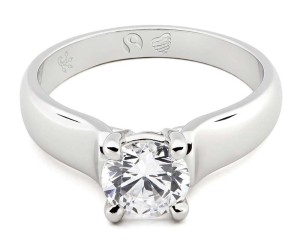Action plan

Taking advantage of this emerging trend for ethical jewellery requires careful planning and allocation of resources. Though ethical sourcing is still a small niche market in North America, differentiating yourself from your competition can provide significant advantage. As ‘conflict’ issues become more prominent, customers will likely seek out jewellers that understand the connection between sourcing and symbolism.
A bridal collection is perhaps the best opportunity in which to introduce a traceable and transparent jewellery line. Wedding and engagement rings possess tremendous symbolism. Nearly all bridal clients can appreciate ethically sourced rings to represent their love and commitment.
For the majority of companies, it makes the most sense to start with a small collection and test your clientele. I have found ethical sourcing is rarely in itself enough of an issue to make someone buy a wedding ring set—the product must also be priced competitively and the designs must be beautiful and stand on their own.
While a few customers might come into your store just to see what you have because of your stance on sourcing, most will view ethical jewellery as an added value, which in the end, might be a tipping point in a sale. All things being equal, it’s been my experience that bridal clients tend to lean toward wedding rings with a back story of a better world attached to them.
A few years ago, many ethical sourcing pioneers had concerns that bringing in traceable product to market raised the risk of clients questioning the origin of all jewellery, leaving a retailer in an awkward position. That is not the case. Just like a supermarket selling organics, you are simply giving the customer a choice that improves the image of your entire company.

Before bringing in a line of ethically sourced jewellery, consider training your staff. Find the salesperson that cares most about these issues and allow him or her to become the expert and train others. It’s critical those who service the customer are both passionate and accurate about ethically sourced jewellery. Once you bring in the line, consider issuing a press release to test your market. Even when all the products in your store are not traceable, your ethical stance can cast a halo over the lines you carry, and may even garner local press looking for a positive story. This last point happened to me this past February when my company was featured in a Valentine’s Day story that ended up on the front page of our newspaper.
Although the exposure got the word out about our store, it was the combination of great design, value, and ethical sourcing that clients found attractive. The first two are a given for producing jewellery that sells. The third allows the customer to feel good knowing their purchase aligns their personal values with economic choices that can support a more beautiful and sustainable future. And you and your company may be contributing to global initiatives to help our industry be as clean as it can be.
Ethical sourcing resources
- Fair Jewelry Action www.fairjewelry.org
- Responsible Jewellery Council (RJC) www.responsiblejewellery.com
- Artisanal Gold Council (AGC) www.artisanalgold.org
- Alliance for Responsible Mining (ARM) www.communitymining.org
- Diamond Development Initiative (DDI) www.ddiglobal.org
- Ethical Metalsmiths www.ethicalmetalsmiths.org
- The Fairtrade Foundation www.fairtrade.org.uk
- Fairtrade Canada www.fairtrade.ca
Marc Choyt is director of Fair Jewelry Action, an environmental justice and human rights network within the jewellery sector. He is president of Reflective Images, a designer jewellery company and manufacturer located in Santa Fe, N.M. Choyt’s book on sustainable business practices, “The Circle Manifesto,” will be published later this year. He can be reached at reflective@cybermesa.com.





